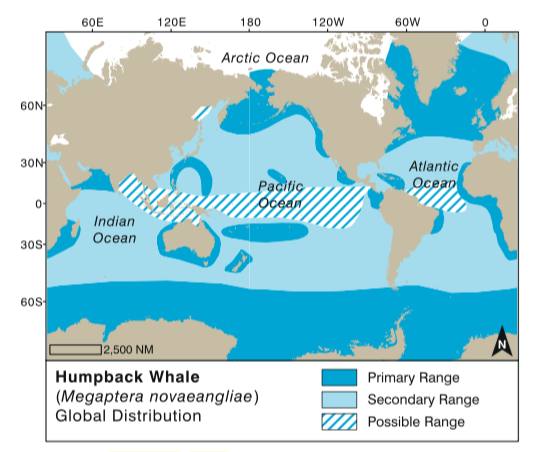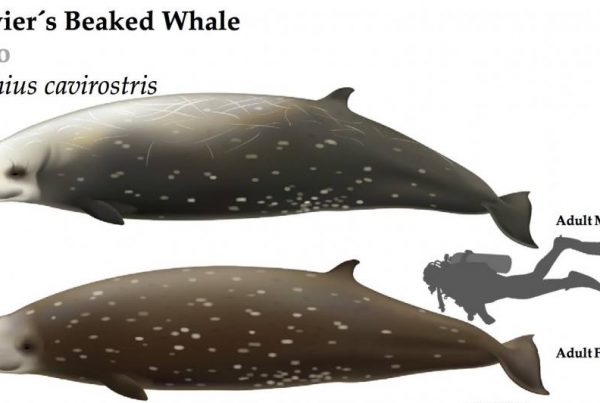
The name « Humpback » comes from the distinctive hump on its dorsal side and also from the way Humpback Whales hunch up their backs before a deep dive.

Humpback Whale (Megaptera novaeangliae) diving and showing the flukes. The trailing edge and the unique black and white pattern on the underside of the caudal fin are visible and can serve to identify the individual.
CHARACTERISTICS
- Latin name : Megaptera novaeangliae
- Suborder : Mysticeti
- Family: Balaenopteridae
- Length : typically 12-13 meters, but can reach up to 19 meters
- Weight : up to 40 tons
- Dive time : up to 40 minutes
- Dive depth: about 600 meters
- IUCN Status: Least concern

DESCRIPTION
Color: The dorsal surface is dark grey or black and the ventral surface is white with black spots. The underside of the caudal is characterized by color patterns that are unique in each individual.
Head: Small but broad and flattened head. It presents several bump-like structures called tubercles, characteristic unique and diagnostic of the species. Tubercles are filled with mechanoreceptors.
Fins: Small triangular or falciform dorsal fin, mounted on a hump (up to 30 cm). The pectoral fins are elongated and present rounded humps that are believed to reduce drag. The pectoral fins can measure around one-third of the body length and are responsible of the Latin name of the genus Megaptera that means “big wing”.
Baleen plates: Dark grey or olive brown. From 270 to 400 plates each side of the upper jaw.
Ventral grooves: 12 to 30 grooves on the treat and chest that extend to the navel.
Blow: Up to 3 meters

Head-Top of a Humpback Whale (Megaptera novaeangliae) with the tubercles typical of the species. Picture courtesy of Lorenzo Fiori.
LIFE HISTORY
DIET
Humpback whales feed on krill, small fish (e.g., herring, sandlance, capelin, mackerel) and other plankton crustaceans. Humpback whales are known for concentrating their prey in one area using bubble net feeding technique.

Humpback Whales (Megaptera novaeangliae) engulfing preys in the middle of a bubble net. Source: NOAA.
REPRODUCTION
Sexual maturity is reached at around 4-10 years. Breeding and calving take place towards the end of Fall/beginning of Winter (for the Northern Hemisphere). Males form competitive groups also referred as “heat runs” chasing a female and performing aggressive displays directed towards the other males. Females give birth to calves every 2 to 3 years and the gestation lasts about 11-12 months. At birth, a new born measure around 4 meters in length.
SOCIAL BEHAVIOR
Humpback Whales are typically found in small and unstable groups, larger aggregations occur in summer in the feeding areas. There is a strong fidelity to breeding and feeding stations. Humpback whales are also well known for their social, aerial behavior at the surface including breaching, lob-tailing, and flipper-slapping.

Humpback Whale (Megaptera novaeangliae) calf breaching. Picture courtesy of Lorenzo Fiori.
VOCAL BEHAVIOR
Humpback Whales produces a vast array of sounds: groans, moans, snores, yups, chirps, yes, dos and various clicks. Males are known to produce complex song patterns that are continuously repeated, especially in the breeding grounds, and vary between different populations. The sounds range from 40 Hertz to 5 kHertz. You can listen a Humpback Whale song in this recording collected by Lawrence Curtis in Vava’u, Kingdom of Tonga.



















